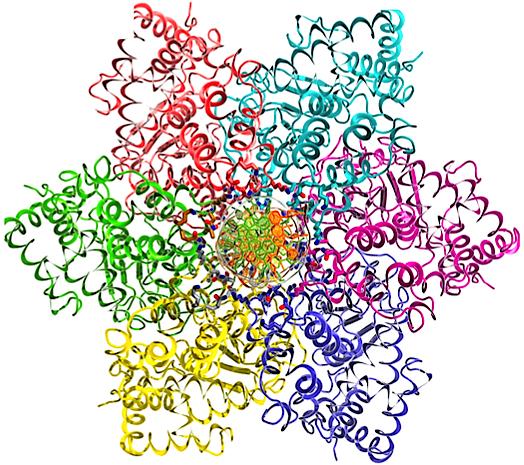



Living cells, unlike ambivalent suitors, need not be told, “If you liked it, you should have put a ring on it.” No, when the cell starts to divide, it places a ring of proteins around a specific site on DNA, the replication origin. This fateful act sets in train a series of molecular events that culminate in the propagation of life to a new generation of cells.

These events are now known in greater detail thanks to new work carried out by a team of researchers based at the University of Southern California (USC). Led by Xiaojiang Chen, Ph.D., a professor of biological sciences and chemistry, the USC team established that the ring of proteins that encircles the DNA origin tightens and causes the bonds between DNA dual strands to break, or “melt.”
Details appeared December 6 in the journal eLife. In an article entitled, “The Structure of SV40 Large T Hexameric Helicase in Complex with AT-Rich Origin DNA,” the USC researchers described how they added to our understanding of DNA replication by following the workings of simian virus 40 (SV40), a cancer-causing virus. The virus, the researchers found, hijacked the DNA replication process with a ring of proteins called a helicase that mimicked the rings of proteins that prompt genetic replication in healthy cells.
“[The] co-crystal structure of the SV40 Large-T Antigen (LT) hexameric helicase bound to its origin dsDNA,” wrote the authors of the eLife article. “The structure shows that the six subunits form a near-planar ring that interacts with the origin, so that each subunit makes unique contacts with the DNA.”
The helicase’s domain channel narrows and compresses the double-stranded (ds) DNA’s phosphate backbones, breaking bonds between base pairs and forcing Watson–Crick base pairs within the duplex to flip outward. This outwardly flipped structure, the scientists noted, “provides the first snapshot of a hexameric helicase binding to origin dsDNA, and suggests a possible mechanism of origin melting by LT during SV40 replication in eukaryotic cells.”
After origin melting occurs, the double helix divides into separate strands. These DNA strands then become the template for faithful duplication of other strands.
“Understanding the mechanisms of origin DNA opening or melting allows us to learn this fundamental process of genetic duplication,” explained Dr. Chen. “The knowledge we have gained may be applicable for future intervention of this process to block the replication of viral pathogens and cancer cells.”
Dr. Chen emphasized that the origin DNA’s opening is an essential step for DNA replication in our cells and for some tumor viral pathogens to replicate and spread. But why focus on origin DNA? What is so special about it? Regular DNA sequences contain the A, T, G, and C nucleotides, more or less in equal ratio. But origin DNA sequences contain more A and T nucleotides than usual.
To prompt replication, Dr. Chen’s team used a helicase from a “Large Tumor Antigen” or Large T. The antigen comes from the SV40 virus linked to human cancers, such as brain and bone cancers, mesothelioma, and lymphoma. The six proteins from Large T comprise a “helicase” that mimics the structure of the healthy cells’ helicases.
Next, the scientists obtained a 3D view of the atomic structure of the helicase using X-ray crystallography. The images the scientists obtained revealed that the proteins surrounding the DNA had attached to it, then tightened like a vise until the bonds between the two strands of the double helix “melted” the origin DNA.
Although the scientists used a cancer-causing virus to study replication, healthy cells replicate in a similar way, Dr. Chen indicated.
 Relevant
news
Relevant
news